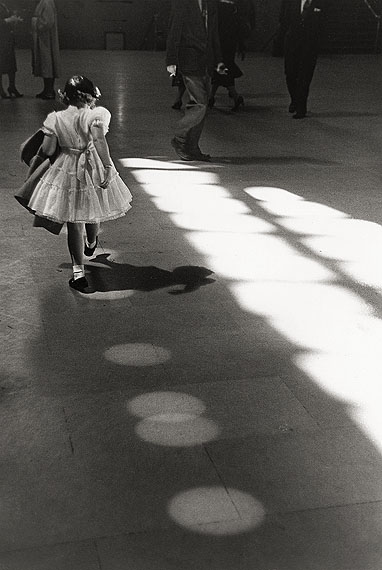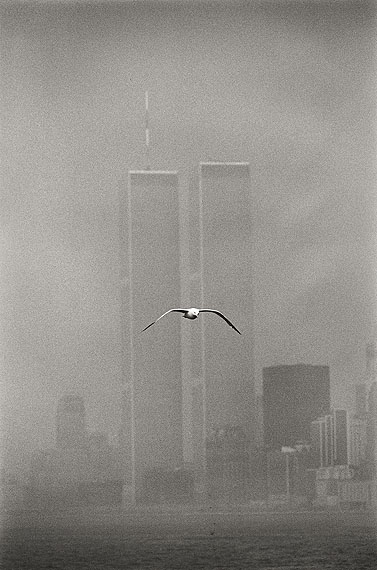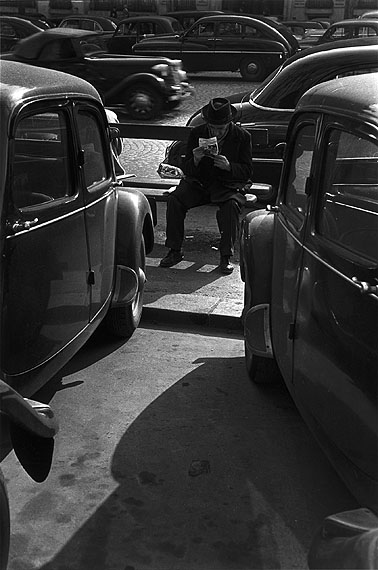
Louis Stettner »
The First Ninety Years
Exhibition: 1 Dec 2012 – 2 Mar 2013
Fri 30 Nov 19:00 - 21:00

Johanna Breede PHOTOKUNST
Fasanenstr. 69
10719 Berlin
+49 (0)30-88913590
photokunst@breede.de
www.johanna-breede.com
Tue-Fri 11-17, Sat 11-14

The with outcry of “There is the sun!” the child Louis Stettner, dramatically gesturing towards the heavens, discovered the most primordial of all light sources. They were, according to him, his first words. It is this youthful fervor, and a never-ending passion for the experience of sight that the 90 year old photographer has retained to this day. The moments that he captures from the river of time fascinate through humor and ambiguity, intuition and empathy, like the picture “Parade Musician,” that resembles a postcard: a short instant, that encompasses a whole life.
At the age of 12 Louis Stettner was already roaming the streets with a photographic eye, and realized early on that the camera could not only serve as an extension of his eye, but also as a medium to express his perceptions and emotions. Born and raised in Brooklyn, it was the exuberant and vibrant Manhattan that cast a spell over the young man. Yet it was in Paris during the post-war years of 1946-1951 that Louis Stettner ultimately became a photographer. He fell in love with the city and its inhabitants, still marked by the austerity and deprivations of the war and German occupation. The aromas of the neighborhoods, the quiet alcoves on the banks of the Seine, and the recent history all around inspired him as much as the Parisians themselves, that came together in the cafés, debated over art, and welcomed him into their circles. Stettner met Brassaï, Édouard Boubat, Willy Ronis, Izis, Robert Doisneau and other photographers, studied film at the University of Paris, and in 1949 exhibited his work for the first time in the “Salon des Indépendants” at the National Library.
In 1951 Stettner moved back to New York and worked among the people, photographing kids playing, the cool guys, the hurried steps through clouds of steam, dwelling in the rain, waiting at the street corner. It is a vision that has importance in the way it combines intellect and sensuality. The greatest beauty is often found in the quiet moments, in a face, a composition, a living detail. In the old Penn Station a little girl is immersed in her game with the light playing across the floor. In Central Park there sits a young couple on a stone bench, Stettner only photographs the flirtation of their arms and legs. With a shot of the Twin Towers we sense the cry of seagulls and the smell of salt water. On a stoop in Battery Park sits a lone black teenager, with a shadowy outline of the Statue of Liberty in the background, a view of New York between reality and myth.
In all these pictures Louis Stettner succeeds in stopping time and imbuing the moment with importance. However, in all of these pictures there remains something unsaid, and it in this aspect that a large portion of their power and significance lies, because of the way each person can see something new in them. Stettner does not judge, he is but a witness and at the same time views the world very personally. We can do the same if we join him on a journey through the decades and share the joy of photography in its ability to capture the irretrievable past. (Susanne Schmid)
The Bibliothèque Nationale de France, Paris shows the Retrospective of Louis Stettners Work from 11th of December 2012 to 27th of January 2013

Mit dem Ausruf "There is the Sun!" entdeckte das Kind Louis Stettner, dramatisch in Richtung Himmel gestikulierend, die ursprünglichste aller Lichtquellen. Es waren wie er selbst berichtet seine ersten Worte. Die jugendliche Leidenschaft, die nie versiegende Lust am Erlebnis des Sehens hat sich der 90jährige Photograph bis heute bewahrt. Die Momente, die er aus dem Fluss der Zeit herauslöst, faszinieren durch Witz und Doppelbödigkeit, Intuition und Einfühlungsvermögen wie in dem Bild des alten "Parade Musician", der sich nach einer Ansichtskarte bückt: ein kurzer Augenblick, der ein ganzes Leben enthält.
Im Alter von 12 Jahren streifte Louis Stettner bereits photographierend durch die Straßen und erkannte früh, dass die Kamera nicht nur Verlängerung seiner Augen, sondern auch Ausdrucksmittel seiner Empfindungen sein konnte. In Brooklyn geboren und aufgewachsen, zog das quirlige und lebenssprühende Manhattan den jungen Mann in seinen Bann. Es war jedoch das Paris der Nachkriegsjahre 1946-1951, in dem Louis Stettner endgültig zum Photographen wurde. Er verliebte sich in die noch von den Entbehrungen des Krieges und der deutschen Besatzung gezeichnete Stadt und ihre Bewohner. Die Gerüche der Quartiers, die stillen Winkel am Seineufer, die überall gegenwärtige Vergangenheit, inspirierten ihn ebenso wie die Pariser selbst, die in den Cafés zusammenkamen, über Kunst debattierten und ihn selbstverständlich in ihre Gemeinschaft aufnahmen. Stettner lernte Brassaï, Édouard Boubat, Willy Ronis, Izis, Robert Doisneau und andere Photographen kennen, studierte Film an der Pariser Universität und stellte 1949 erstmals seine Arbeiten im "Salon des Indépendants" in der Bibliothèque Nationale aus.
1951 kehrte Stettner nach New York zurück und mischte sich unter die Menschen, photographierte die spielenden Kinder, die coolen Jungs, den eilenden Schritt durch Dampfwolken, das Verweilen im Regen, das Warten an der Straßenecke. Es ist ein Sehen, das Gewicht hat, in dem Verstand und Sinnlichkeit zusammenkommen. Die größte Schönheit liegt oftmals in den stillen Momenten, in einem Gesicht, einer Komposition, einem lebendigen Detail. In der alten New Yorker "Penn Station" ist ein kleines Mädchen ganz in sein Spiel mit den auf den Boden fallenden Lichtern versunken. Im Central Park sitzt ein junges Paar auf einer steinernen Bank, Stettner photographiert nur den Flirt ihrer Arme und Beine. Beim Blick auf die "Twen Towers" vermeinen wir den Schrei der Möwe zu hören und die salzige Meerluft zu riechen. Auf einem Geländer im Battery Park sitzt einsam ein schwarzer Junge, in seinem Rücken schemenhaft die Freiheitsstatue, eine Ansicht von New York zwischen Realität und Mythos.
In all diesen Bildern gelingt es Louis Stettner, die Zeit still stehen zu lassen und dem Augenblick Bedeutung zu verleihen. In all diesen Bildern bleibt aber auch etwas Ungesagtes, und gerade darin liegt ein großer Teil ihrer Kraft und Gültigkeit, denn sie können von jedem Betrachter neu gesehen werden. Stettner wertet nicht, er ist Zeitzeuge und nimmt die Welt dennoch ganz persönlich. Das können auch wir, wenn wir mit ihm auf Streifzug durch die Jahrzehnte gehen und die Freude des Photographen am Festhalten des Unwiederbringlichen teilen. (Susanne Schmid)
Zeitgleich zeigt die "Bibliothèque Nationale de France" in Paris vom 12. Dezember 2012 bis zum 27. Januar 2013 eine Retrospektive von Louis Stettners Werk.
